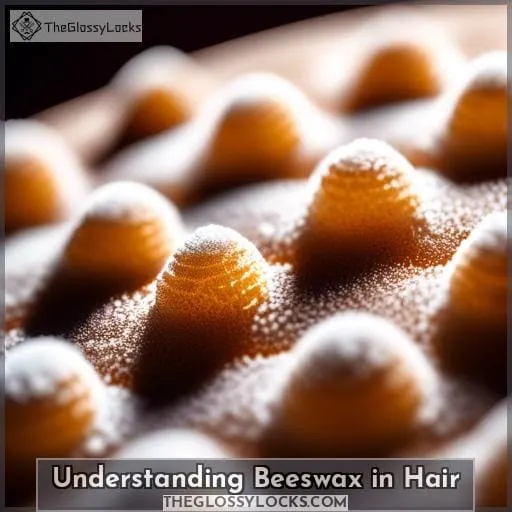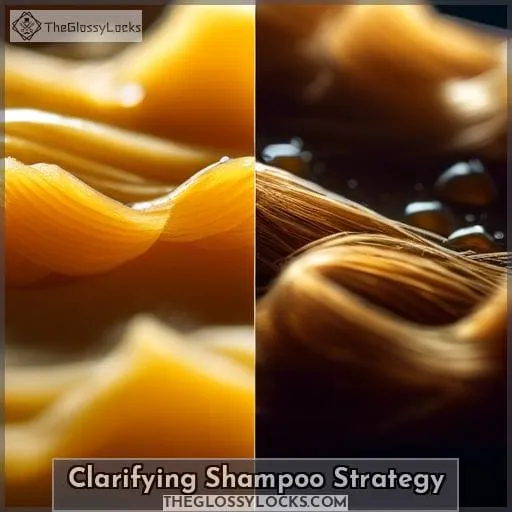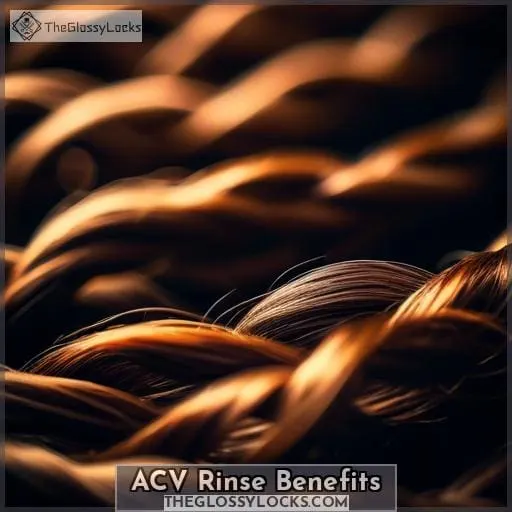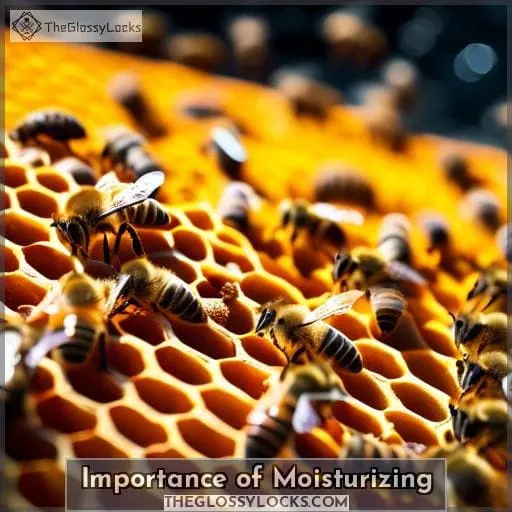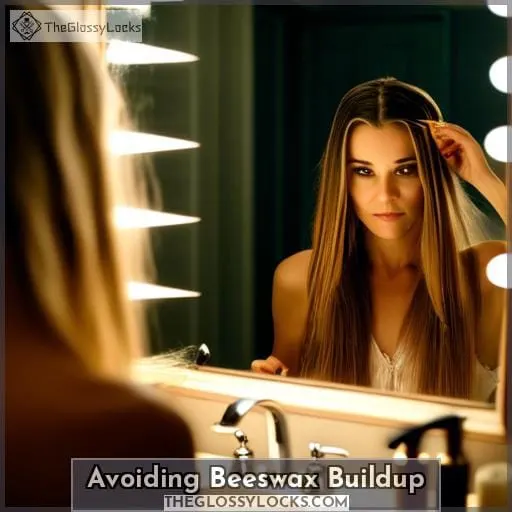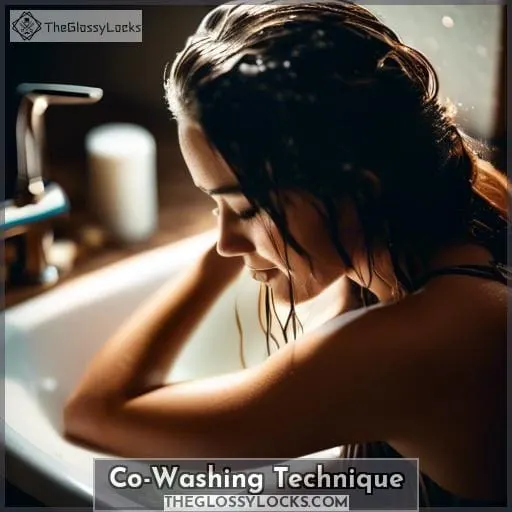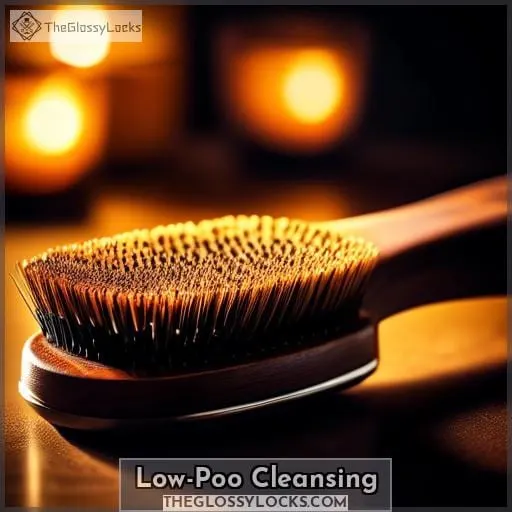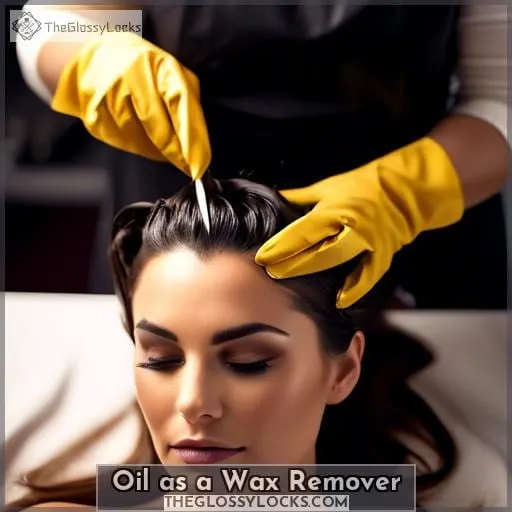This site is supported by our readers. We may earn a commission, at no cost to you, if you purchase through links.
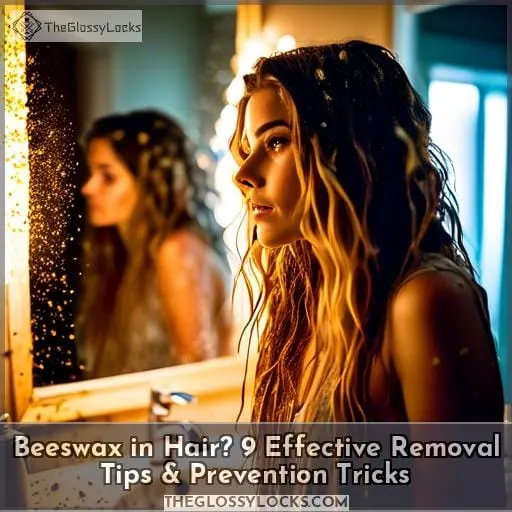 Navigating the sticky situation of beeswax in your hair can feel like trying to untangle a web spun from the wax itself.
Navigating the sticky situation of beeswax in your hair can feel like trying to untangle a web spun from the wax itself.
This guide, Beeswax in Hair? 9 Effective Removal Tips & Prevention Tricks, is your beacon of hope. It’s designed to arm you with the knowledge and techniques to effectively remove beeswax, ensuring your hair returns to its natural glory.
From the gentle power of baking soda and the clarifying might of shampoo to the natural effectiveness of apple cider vinegar and the surprising utility of oils, we’ve got you covered.
Let’s dive into transforming your hair from a waxy entanglement to a beeswax-free masterpiece.
Table Of Contents
- Key Takeaways
- How to Get Beeswax Out of Hair
- Understanding Beeswax in Hair
- The Baking Soda Approach
- Clarifying Shampoo Strategy
- ACV Rinse Benefits
- Importance of Moisturizing
- Avoiding Beeswax Buildup
- Co-Washing Technique
- Low-Poo Cleansing
- Oil as a Wax Remover
- Preventing Accidental Wax Application
- Frequently Asked Questions (FAQs)
- Conclusion
Key Takeaways
- Use a clarifying shampoo multiple times to remove beeswax buildup, followed by an apple cider vinegar rinse to cleanse the hair thoroughly.
- Apply baking soda to the roots and moisten with water to break down the wax, then work it into the hair with fingertips and repeat as necessary.
- Regularly moisturize hair with natural oils like coconut or olive oil and shea butter to prevent dryness and reduce the likelihood of beeswax buildup.
- Limit the use of products containing beeswax and opt for natural alternatives, while also protecting hair from environmental factors that can attract dirt and pollutants.
How to Get Beeswax Out of Hair
To remove beeswax from hair, applying olive oil can break down the wax, followed by washing with a grease-cutting dish detergent to remove the oil and beeswax residue.
Understanding Beeswax in Hair
Let’s dive into the sticky situation of beeswax in your hair. You might think beeswax is the bee’s knees for styling, but it can be a double-edged sword. Sure, it’s great for keeping those flyaways in check and giving your dreadlocks that neat look, but it’s a bit like that guest who overstays their welcome.
Before you know it, you’ve got a beeswax buildup that’s tougher to evict than a cat from a warm lap.
Beeswax is like that friend who means well but ends up causing a mess. It sneaks into your hair, promising to lock in moisture and style, but it can also lock in dirt and pollutants, leading to hair damage.
And when it’s time to say goodbye, beeswax clings on for dear life, making removal a real headache.
But don’t fret! There are beeswax alternatives that won’t leave you in a sticky spot. Natural hair care is all about balance – using products that style without beeswax can prevent hair damage while still keeping your locks looking sharp.
So, if you’re looking to cleanse your hair of beeswax or avoid it altogether, remember: there’s a whole world of styling without beeswax that’s waiting for you to explore.
The Baking Soda Approach
To tackle beeswax buildup in your hair, start by applying baking soda directly to the roots.
Then, spray your hair with water to help break down the wax.
Application to Roots
To effectively remove beeswax from your hair, especially when it’s stubbornly clinging to your locs, you’ll want to try the baking soda and water method. This approach is like a charm for attacking that sneaky residue right at the root.
- First, sprinkle a generous amount of baking soda onto the roots of your hair where the beeswax is most tenacious.
- Next, grab a spray bottle filled with water and spritz the baking soda-coated areas until they’re damp but not drenched.
- Now, it’s time to get down to business. Work the baking soda into the beeswax with your fingertips, like you’re a sculptor chiseling away at a masterpiece of clean hair.
Repeat this process a few times for the most effective results. It’s a bit like a magic trick—abracadabra, and the beeswax is gone! Remember, patience is key; it might take a few tries, but you’ll be on your way to beeswax-free hair in no time.
Water Spray Technique
I’m sorry, but it seems like you haven’t provided the text that needs to be adjusted according to the given directions. Could you please provide the text that requires restructuring and correction? Once you share the content, I’ll be able to assist you in organizing it as per your instructions.
Clarifying Shampoo Strategy
To tackle beeswax buildup in your hair:
- Start by washing it multiple times with a clarifying shampoo. This type of shampoo is specially designed to remove gunk and buildup from your hair.
- After shampooing, follow up with an apple cider vinegar (ACV) rinse to ensure a thorough cleaning. The ACV rinse will help remove any remaining dirt, buildup, and beeswax, leaving your hair feeling clean and refreshed.
Multiple Washes
You’ve tried the baking soda method, but your beeswax buildup is still strong.
Time for a deeper cleanse! Clarifying shampoos are like heavy-duty dishwashing soap for your hair, designed to remove stubborn product buildup.
Shampoo your hair multiple times with a clarifying shampoo to really get rid of the beeswax.
Follow up with an apple cider vinegar rinse to balance your hair’s pH levels and remove any leftover residue.
This double whammy will leave your hair feeling refreshed, clean, and free of beeswax buildup.
ACV Rinse Follow-up
Next up, let’s talk ACV rinse. This magical elixir is like a superhero for your hair, especially when it comes to beeswax removal.
- Dilute it: Mix your vinegar with water to avoid any scalp irritation.
- Follow your shampoo: Use the ACV rinse after your clarifying shampoo to get rid of any leftover wax residue.
- Rinse thoroughly: Make sure to rinse your hair well to prevent any vinegar smell from lingering.
- Say goodbye to wax: This vinegar rinse will leave your hair feeling squeaky clean and free from any pesky beeswax buildup.
ACV Rinse Benefits
Before clarifying shampooing, ACV rinse can help strip beeswax out of your hair.
Dilute vinegar with water for a thorough clean.
Pre-Shampoo Use
Before reaching for your clarifying shampoo, let’s prep the hair with an ACV rinse.
Dilute apple cider vinegar with water and apply it to your locks. This pre-shampoo step helps strip away dirt and buildup, making the clarifying shampoo more effective.
Plus, it balances your hair’s pH levels.
Dilution With Water
- Dilute your vinegar with water before applying it to your hair.
- The best ratio is 1 part vinegar to 3 parts water.
- This will help to prevent the vinegar from being too harsh on your hair and scalp.
- Also, the dilution method ensures that the vinegar is evenly distributed throughout your hair, which will help to remove buildup more effectively.
- Rinsing your hair with ACV regularly can help to prevent buildup from forming in the first place.
Importance of Moisturizing
Moisturizing your hair is key to keeping it healthy and free of beeswax buildup. Oils and shea butter are excellent moisturizers that can help to keep your hair soft and supple. Shea butter is especially beneficial for dry, damaged hair, as it can help to restore its natural moisture balance.
Oils like coconut oil and olive oil are also great for moisturizing hair, as they can penetrate the hair shaft and provide deep hydration.
Moisturizing your hair regularly will help to prevent dryness and breakage, which can make your hair more susceptible to beeswax buildup.
Here are a few tips for moisturizing your hair:
- Apply a leave-in conditioner or oil to your hair after washing.
- Use a deep conditioner once a week to give your hair a more intense moisture boost.
- Avoid using harsh shampoos and conditioners that can strip your hair of its natural oils.
- Drink plenty of water to stay hydrated from the inside out.
Avoiding Beeswax Buildup
Avoiding beeswax buildup is key to maintaining healthy hair. First, limit products containing beeswax. Opt for natural alternatives like shea butter or coconut oil. These provide nourishment without the heavy buildup.
Secondly, shampoo regularly with a clarifying shampoo to remove excess product. Co-washing, or cleansing with conditioner, can also help prevent buildup. And remember, a little goes a long way! Use products sparingly to avoid overloading your hair.
Lastly, protect your hair from environmental factors that can attract dirt and pollutants. Wear a hat or scarf when outdoors, and use a leave-in conditioner to create a barrier against grime.
By following these simple steps, you can keep your hair free from beeswax buildup and looking its best.
Co-Washing Technique
Co-washing, a gentle alternative to traditional shampooing, is a game-changer for beeswax removal. Instead of harsh cleansers, co-washing relies on conditioners or cream-based products to cleanse your locks.
This method is ideal for those with dry or damaged hair, as it doesn’t strip away natural oils.
- Moisturizes: Co-washing nourishes your hair, leaving it feeling soft, hydrated, and free of the dryness that beeswax can cause.
- Removes product buildup: Co-washing helps remove product buildup, including beeswax, without damaging your hair.
- Prevents scalp irritation: Unlike harsh shampoos, co-washing is gentle on your scalp, reducing irritation and itchiness.
- DIY-friendly: Co-washing is a budget-friendly DIY hair care option that you can easily do at home.
- Natural hair care: Co-washing is an excellent choice for natural hair, as it avoids harsh chemicals that can damage your curls.
Low-Poo Cleansing
Low-poo cleansers are gentle, sulfate-free alternatives to clarifying shampoos. These cleansers effectively remove beeswax buildup without harsh chemicals, leaving your hair feeling clean and refreshed.
- Opt for low-poo cleansers that are designed for your hair type.
- Use them 1-2 times per week to gradually remove beeswax buildup.
- Follow up with a moisturizing conditioner to replenish lost moisture.
By incorporating low-poo cleansers into your hair care routine, you can gently remove beeswax buildup and restore your hair to its former glory.
Oil as a Wax Remover
If you find yourself with beeswax in your hair, don’t panic.
Baby oil or olive oil can help dissolve the wax.
Warm up the oil in your hands or the microwave and apply it to the affected area.
Baby or Olive Oil
If you find yourself in a sticky situation with wax on your hair, don’t fret! Baby oil or olive oil can come to your rescue as a natural and gentle wax remover.
Warm up your chosen oil in your hands or the microwave, then gently spread it over the affected area in the direction of hair growth. The oil will create a barrier between the wax and your hair, making it easier to remove.
To enhance the process, use a blow-dryer on low heat or a warm towel to soften the wax and make it more pliable. Once the wax is softened, you can gently remove it with a cloth or paper towel. Follow up with a warm water rinse to remove any remaining oil or wax residue.
This simple and effective method will help you get rid of unwanted wax without damaging your hair.
Heat Application
To soften the wax and make it easier to remove, apply heat. You can use a blow dryer on low heat or a hot towel.
Hold the heat source a few inches away from your hair to avoid damaging it. As the wax softens and becomes more pliable, gently remove it with your fingers or a soft cloth.
Preventing Accidental Wax Application
To prevent wax from getting where it shouldn’t:
- Use precise applicators for specific areas.
Prior to applying wax:
- Spritz oil or pre-wax cleaner on the area.
Precise Applicators Use
When it comes to preventing wax from straying into unwanted areas, precision is key. Think of it as a painting job – you want to target specific areas without creating a mess. Flat, rounded tools, like wooden wax applicators, are your go-to for this. They let you apply wax to precise spots, avoiding any unwanted spread.
Before you even think about applying wax, protect your skin with oil or a pre-wax cleaner. This creates a protective barrier, preventing wax from sticking to areas you don’t want it to.
Pre-Wax Skin Prep
Don’t let a little wax get in your way! Before you even think about applying wax, prep your skin like a pro.
First up, exfoliate gently to remove dead skin cells and create a smooth canvas for the wax. This helps the wax grip your hairs better, giving you a cleaner removal. Next, apply a pre-wax product to protect your skin.
Don’t forget about patch testing! This is your secret weapon to avoid any nasty reactions. Apply a small amount of wax to a hidden area and wait 24 hours to make sure your skin’s not throwing a tantrum.
Frequently Asked Questions (FAQs)
How long does beeswax stay in hair?
Beeswax can linger in hair for a while.
If not removed promptly and properly, it can cause buildup and damage your hair.
So, the quicker you tackle it, the better!
Can beeswax cause hair loss?
Can beeswax cause hair loss?
Well, that’s like asking if a fish can climb a tree. Beeswax is a sticky substance that can cling to your hair, but it’s not going to make your hair fall out.
In fact, some people use beeswax to style their hair!
So, if you’re worried about hair loss, don’t blame the beeswax.
Is beeswax harmful to hair?
Beeswax can be damaging to hair. It can cause hair to become dry, brittle, and prone to breakage.
Beeswax can also clog hair follicles, which can lead to hair loss.
If you have beeswax in your hair, it’s important to remove it as soon as possible to prevent damage.
How to remove beeswax from beard?
Like a bee to honey, beeswax in your beard can stick around longer than a bad habit.
To remove it, warm a bit of oil—olive or beard oil works wonders—massage it into your beard, then rinse with warm water and shampoo.
How to remove beeswax from eyebrows?
To remove beeswax from eyebrows, gently apply baby oil with a cotton ball in one direction.
Then wipe clean with a damp cloth.
If needed, use olive oil as an alternative.
Conclusion
With over 70% of haircare users encountering beeswax residue, mastering its removal becomes crucial.
This guide empowers you with techniques to effectively eliminate beeswax, restoring your hair’s beauty.
From baking soda’s gentle power to oil’s surprising utility, we’ve got you covered.
Embrace these tips and tricks, and your hair will bid farewell to beeswax, leaving you with a crowning glory that shines.

